Choosing the Safest cooking utensils is more than just a matter of convenience—it’s about safety and health. With so many materials and designs available, knowing which tools are safe for everyday use can be overwhelming. From non-toxic plastics to eco-friendly bamboo and heat-resistant metals, the options are endless. In this guide, we’ll explore what makes a cooking utensil safe, the best materials to use, and tips for keeping your kitchen both functional and healthy. Whether you’re a seasoned chef or just starting out, understanding the safest cooking utensils can make a big difference in your meals and overall well-being.
What Safe materials for cooking tools
When you cook, you use different types of tools like spoons, forks, spatulas, and knives. If you use the wrong utensils, you could harm yourself or even get sick. Some utensils can cause scratches or burns. while others may even release harmful chemicals into your food.
Choosing the Safest Cooking utensils is very important. Let’s dive into the types of utensils that are safest to use and why they matter.
Wooden Cooking Utensils
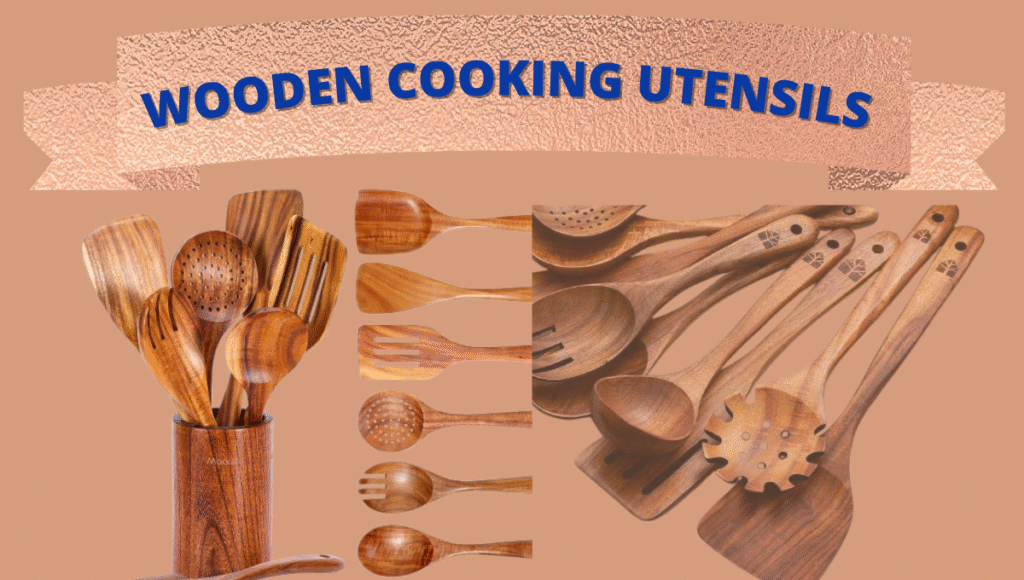
One of the safest choices for cooking utensils is wood. Wooden spoons, spatulas, and forks are excellent options. Here’s why:
- Non-toxic: Wood does not release harmful chemicals into your food. Unlike plastic, wooden utensils are free from BPA (Bisphenol A), which can be harmful to your health.
- Wooden utensils are soft. so they won’t scratch or damage your cookware, especially non-stick pans.
- Durable: If taken care of properly, wooden utensils can last a long time. They don’t bend or break easily, making them a cost-effective choice.
However, it’s important to clean wooden utensils well after every use. This helps prevent the growth of bacteria. You should also oil them from time to time to keep the wood from drying out.
Stainless Steel Utensils

Another safe option is stainless steel. Many kitchens use stainless steel knives, spoons, spatulas, and forks. Here’s why it’s a good choice:
- Durability: Stainless steel utensils are strong, long-lasting, and resistant to rust. This means they’ll last much longer. They’ll stay in good condition over time.
- Non-reactive: Stainless steel does not react with food. This makes it safe to use with acidic foods like tomatoes or citrus.
- Easy to clean: Stainless steel is simple to clean. It’s safe to wash by hand or toss into the dishwasher for easy cleaning.
The only downside is that stainless steel can sometimes scratch non-stick cookware. But, if you have stainless steel pans, these utensils will work perfectly.
Silicone Utensils
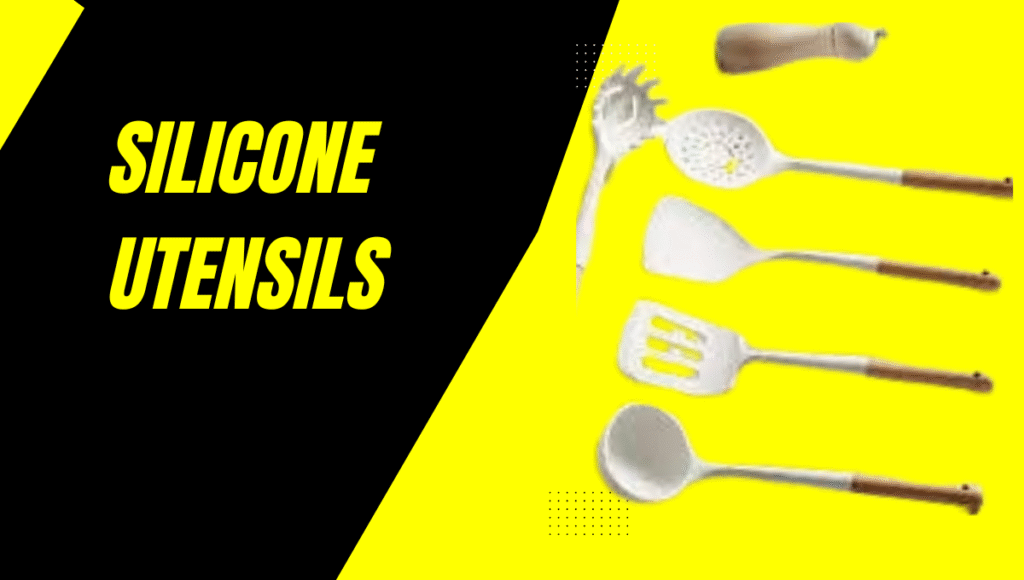
Silicone is becoming a popular material for cooking utensils. You’ll see it used in everything from spoons and spatulas to whisks and beyond.. Why is silicone a great choice?
- Heat-resistant: Silicone can handle high heat without melting or releasing chemicals. This makes it perfect for cooking at high temperatures, like when frying or grilling.
- Non-stick: Since silicone is soft and smooth, it won’t scratch or damage non-stick cookware.
- Non-toxic: Food-grade silicone is completely safe for cooking. It does not contain harmful chemicals. This makes it a good choice for people who are health-conscious.
- Simple to maintain: Silicone utensils can go straight into the dishwasher and require minimal effort to clean.. They also don’t stain or absorb odors from food.
One thing to remember is that silicone utensils can sometimes get soft over time. This is especially true with heavy use. But overall, silicone is one of the safest materials for cooking tools.
Bamboo Utensils
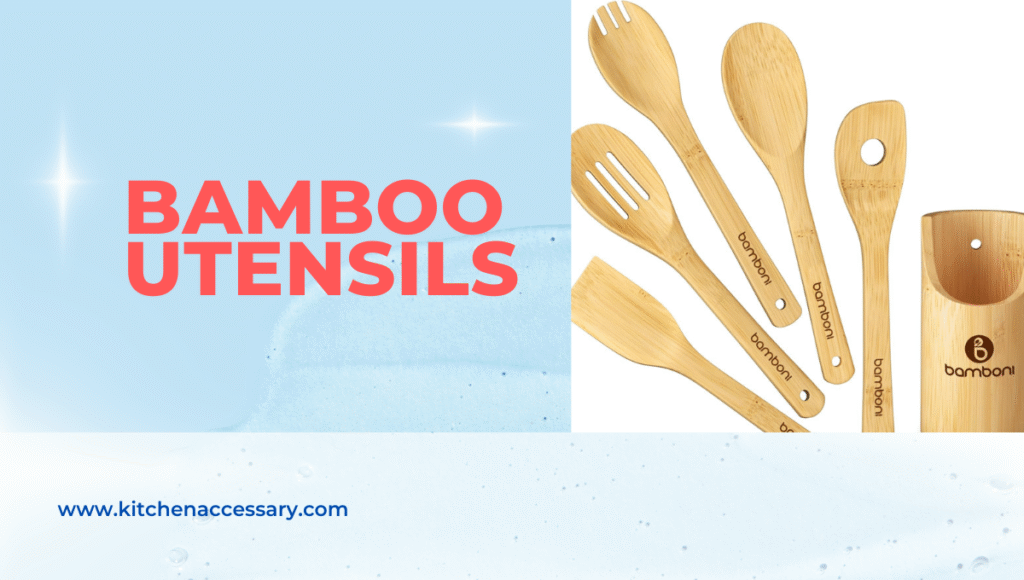
Bamboo is another excellent choice for cooking utensils. Bamboo spoons, forks, and spatulas are very popular. Here’s why:
- Eco-friendly: Bamboo is a natural and sustainable material. It grows quickly and is a renewable resource, which makes it great for the environment.
- Bamboo does not release any harmful chemicals. That means it’s a healthier choice for both you and your loved ones. It’s a great alternative to plastic utensils.
- Strong and durable: Bamboo is stronger than wood, so it is very durable. It won’t break easily, and it can withstand high heat.
Like wooden utensils, bamboo tools should be cleaned properly to avoid bacteria buildup. Bamboo is also sensitive to moisture, so it’s important to dry it after washing.
Cast Iron Utensils
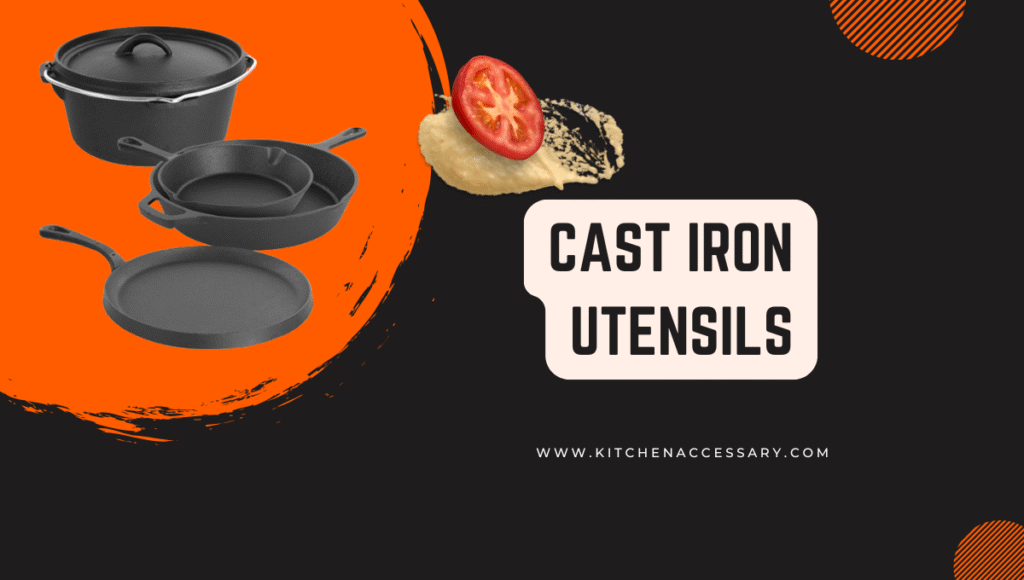
Cast iron utensils, like spoons and spatulas, are also safe, but they are not as common as the others. Here’s why cast iron is good for cooking:
- Non-reactive surface: Cast iron, much like stainless steel, won’t interact with the ingredients you cook. This makes it safe to use with all types of ingredients.
However, cast iron utensils need special care. To keep rust away, it’s important to season them on a regular basis. They are also heavier than other materials, which may not be suitable for everyone.
Plastic Cooking Utensils
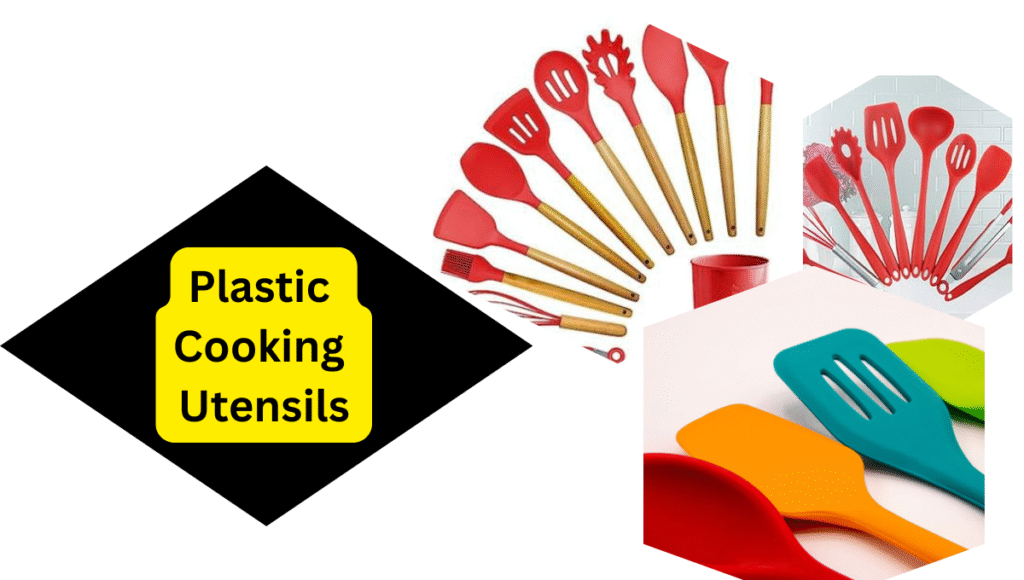
Plastic cooking utensils are very common in many kitchens, but how safe are they? While plastic utensils are not as harmful as some people think, you still need to choose the right ones. Here’s why:
- Plastic utensils are great for non-stick cookware. They won’t scratch the surface, keeping your pans in good condition.
- Plastic utensils are easy to handle and light. They are perfect for children or those with difficulty holding heavier tools.
However, plastic utensils can be harmful if they are made from low-quality materials. BPA-free plastic is a must, as it ensures safety in the kitchen. BPA (Bisphenol A) can leach into food and cause health problems. Check the label to ensure your plastic utensils are chemical-free. Plastic utensils are also not as durable as metal or wood. They can melt under high heat, so they are not suitable for high-temperature cooking. For safety, always use plastic utensils with
Ceramic Utensils
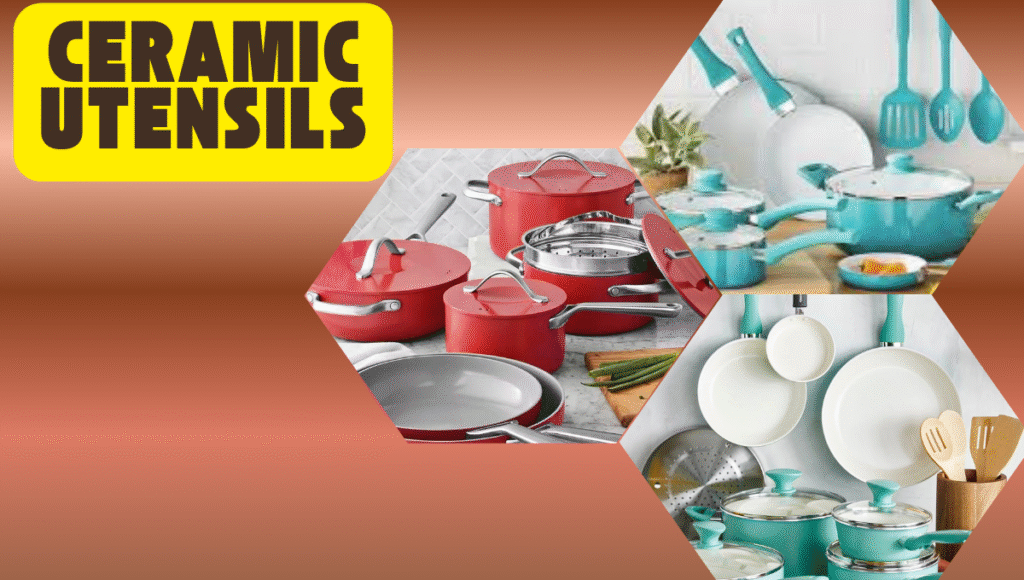
Ceramic is not as commonly used in cooking utensils, but it can be a safe option in some cases. Here’s why:
- Ceramic is non-reactive and doesn’t interact with food. This makes it safe to use with any ingredients.
- Ceramic utensils are chemical-free, ensuring they’re safe for your health.
- Durable: High-quality ceramic utensils are long-lasting and resistant to stains. They are also heat-resistant to some extent.
The downside of ceramic utensils is that they are fragile. Ceramic tools can break or chip easily if dropped, so you need to be careful with them. They’re not ideal for tough jobs such as mixing dense batters or frying
Carbon Steel Utensils
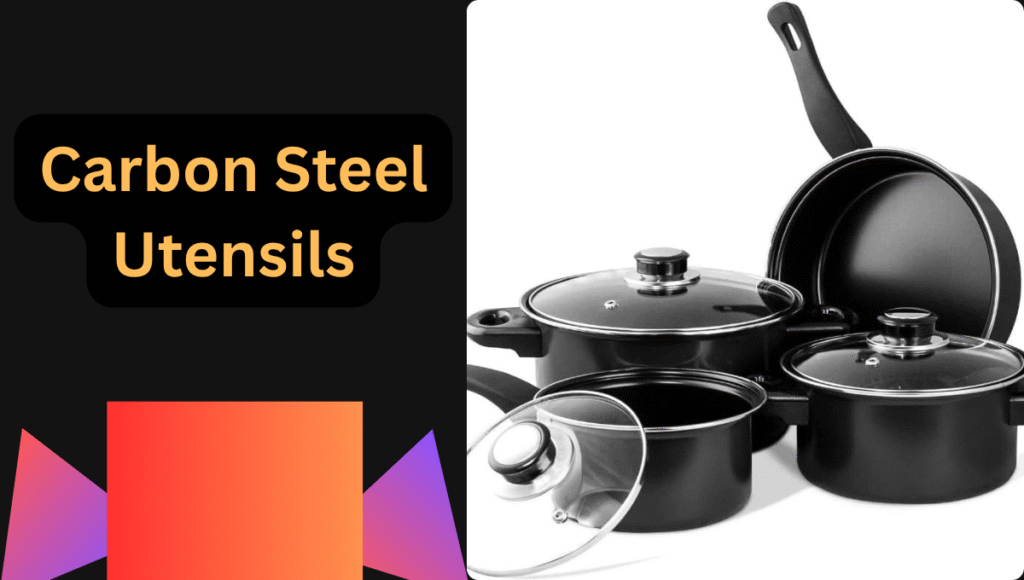
Carbon steel utensils, like knives and spatulas, are becoming more popular. They are especially favored for certain types of cooking. Here’s what you need to know:
- Carbon steel knives and utensils are renowned for their exceptional sharpness. This sharp edge makes them ideal for precision cutting. They are perfect for cutting, slicing, and chopping ingredients with ease.
- Like stainless steel, carbon steel is non-reactive. As a result, it won’t alter the flavor or quality of your food. This ensures the integrity of the taste remains intact.
- Long-lasting strength: With proper care, carbon steel utensils can serve you for decades.
However, carbon steel needs proper care. Without regular seasoning, they can easily start to rust.. Make sure you keep your carbon steel utensils dry and clean to avoid damage.
Copper Utensils

Copper is often used in cookware, but what about copper utensils? Is it actually safe to use them for cooking?
- Copper utensils are safe to use for most cooking tasks. They are non-reactive with food, making them a good choice.
- Copper conducts heat very well. This makes it great for evenly cooking food.
One downside of copper utensils is their tendency to react with acidic ingredients. This can cause your food to pick up an unwanted metallic flavor. For this reason, copper utensils are not recommended for high-acid ingredients. Ingredients like tomatoes or vinegar can cause this issue.
Copper utensils typically come with a lining, like stainless steel, to make them safer for cooking. This coating helps prevent direct contact with food.. Always check for proper coating if you choose copper utensils.
How to Care for Cooking Utensils
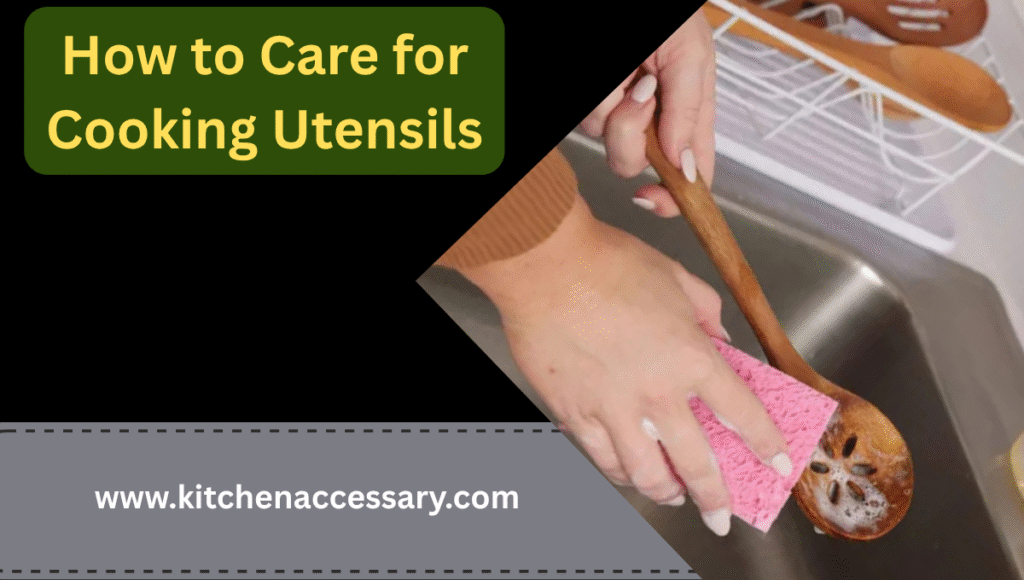
Follow basic maintenance tips to keep your cooking utensils safe. Here are some general guidelines:
- Regular Cleaning: Always clean your utensils thoroughly after each use. This helps to prevent bacteria buildup and keeps your utensils in good condition. For most materials, warm soapy water is enough. However, check the manufacturer’s instructions for any special care.
- After washing your utensils, make sure to dry them properly. Wooden, bamboo, and ceramic utensils should be dried thoroughly. This helps avoid mold or cracking.
- Avoid Harsh Chemicals: Do not use harsh chemicals to clean your utensils. Stick to natural dish soap or a mild cleaner to protect the material.
- Proper Storage: Store your utensils properly to prevent damage. Wooden and bamboo utensils should be stored in a dry place to avoid warping. Metal utensils can be stored in a drawer or utensil holder.
- Seasoning Cast Iron: If you use cast iron utensils, make sure to season them regularly. Applying seasoning protects against rust and ensures a smooth, non-stick surface. Apply a thin layer of oil to your cast iron utensils. Then heat them to create a protective coating.
- Some materials, like plastic and silicone, can melt if exposed to very high heat. It’s important to avoid overheating these materials. Always be mindful of the temperature and avoid using plastic utensils in hot pans.
- This is a guide to selecting the safest kitchen tools tailored to your cooking preferences:
- Different types of cooking require different utensils. Pick the best and safest kitchen tools by thinking about how you like to cook. Your cooking style helps decide what tools work best for you.
- For Frying: If you’re frying food, choose silicone or stainless steel utensils. Silicone is heat-resistant and gentle on non-stick pans. Stainless steel can withstand high temperatures. It also holds up well under heavy use.
- For Baking: Wooden or silicone utensils are excellent for baking. They are gentle on baking sheets and mixing bowls. For precision, you may want to choose a wooden spoon for stirring dough or batter.
- If you love stir-frying, stainless steel or wooden utensils are great choices. These materials are perfect for handling high heat during stir-frying. Stainless steel handles heat well, while wooden utensils won’t scratch your wok or frying pan.
- For Cutting: If you need to chop and slice, carbon steel or stainless steel knives are your best option. These materials keep their sharpness and are excellent for precise cutting.
Conclusion
In conclusion, the safest cooking utensils are made from non-toxic materials. They should also be durable and heat-resistant. Wooden, stainless steel, and silicone utensils are some of the best choices. These materials are ideal for your kitchen. They are safe, reliable, and easy to maintain. Remember to follow proper care instructions to keep your utensils in top condition.
Choosing the right utensils makes meal prep easier and safer. It’s also about ensuring you and your family are safe from harmful chemicals and damage. Whether you are frying, baking, or cutting, always opt for the best quality utensils. This guarantees a secure and pleasant cooking experience.
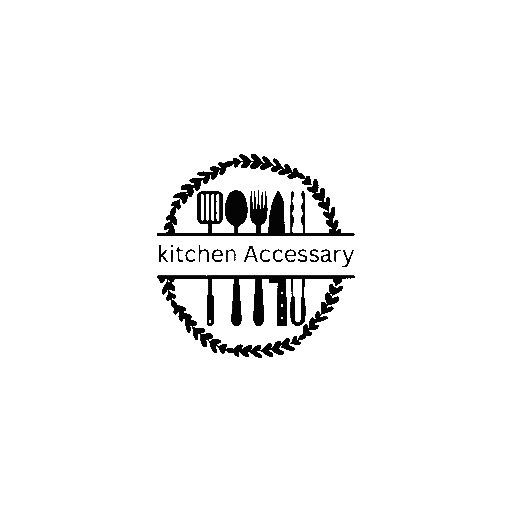
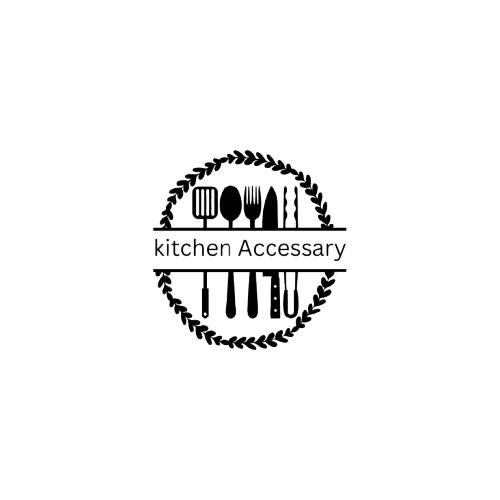
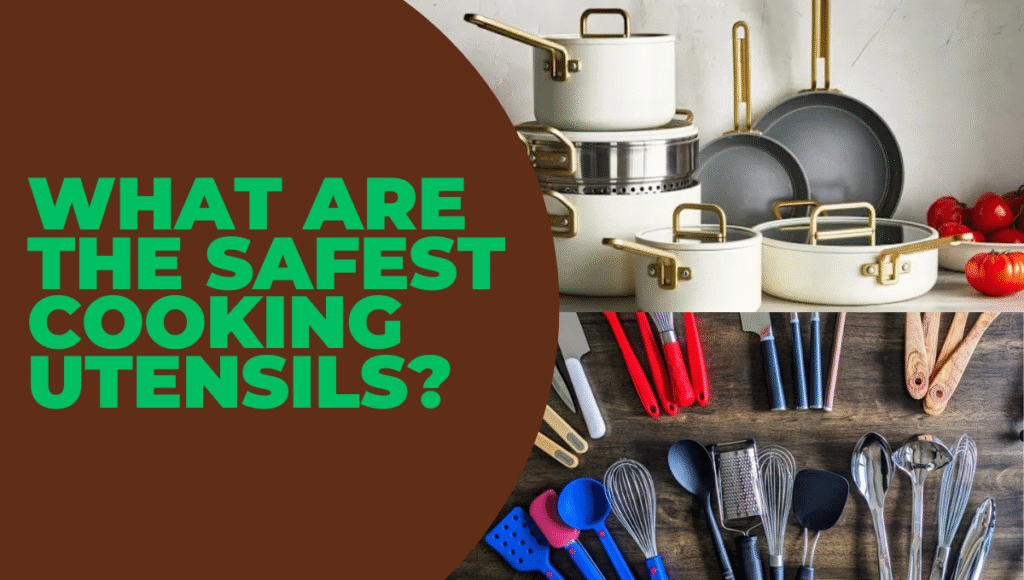

2 Comments
Pingback: Best Olive Oil Sprayer for Cooking simple guide in 2025
Pingback: Best Way to Clean Kitchen Stainless Steel Sink in 2025